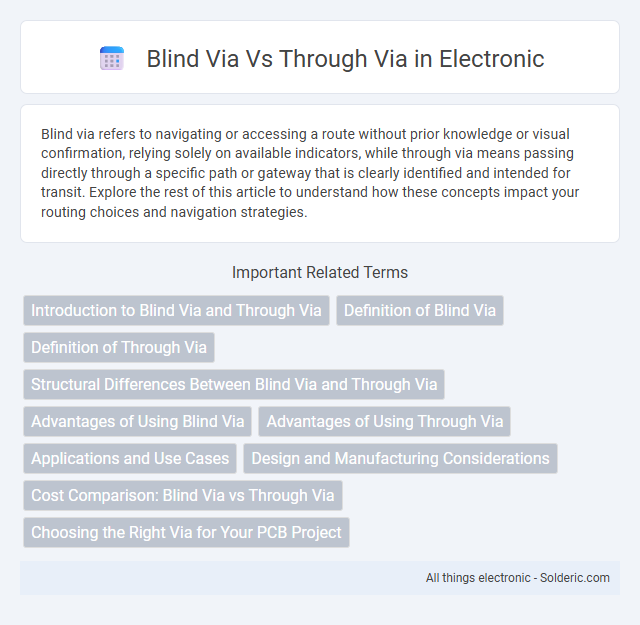Blind via refers to navigating or accessing a route without prior knowledge or visual confirmation, relying solely on available indicators, while through via means passing directly through a specific path or gateway that is clearly identified and intended for transit. Explore the rest of this article to understand how these concepts impact your routing choices and navigation strategies.
Comparison Table
| Feature | Blind Via | Through Via |
|---|---|---|
| Definition | A via that connects an outer layer to one or more inner layers but does not go through the entire PCB. | A via that passes completely through the PCB, connecting all layers. |
| Layers Connected | Outer layer to inner layer(s) | All layers from top to bottom |
| PCB Thickness Impact | Less impact on overall board thickness, allows multi-layer dense routing. | Requires full thickness drilling, may affect mechanical strength. |
| Manufacturing Complexity | Higher due to precise drilling and plating of inner layers. | Lower, through-hole drilling standard. |
| Cost | Generally higher due to complexity. | Lower cost, simpler process. |
| Use Case | High-density PCBs, space-constrained designs. | Standard multi-layer PCBs with simpler interconnects. |
Introduction to Blind Via and Through Via
Blind vias connect an outer layer to one or more inner layers without extending through the entire printed circuit board (PCB), enhancing signal integrity and saving space. Through vias, in contrast, penetrate all layers of the PCB, providing robust electrical connections but occupying more board area. Understanding the differences between blind via and through via allows you to optimize your PCB design for performance, cost, and manufacturing complexity.
Definition of Blind Via
A blind via is an electrical connection that links an internal PCB layer to an outer layer without passing completely through the board, enhancing signal integrity and saving space. This contrast with a through via, which extends from one outer layer to the other, traversing all layers within the PCB. Understanding the function of a blind via is crucial for designing compact, high-performance circuit boards that meet your specific electronic requirements.
Definition of Through Via
Through via refers to an electrical connection in a multilayer printed circuit board (PCB) that passes completely through all layers, allowing signals or power to travel from one side of the board to the other. This type of via is crucial for interconnecting different layers in complex PCB designs, ensuring reliable conductivity across the entire board thickness. You benefit from through vias when your circuit requires robust and continuous electrical pathways spanning multiple layers.
Structural Differences Between Blind Via and Through Via
Blind vias connect only outer layers to one or more inner layers without passing through the entire PCB, unlike through vias that extend from the top to the bottom layer, creating a complete electrical path. The structural distinction lies in the drilling process; blind vias require precise drilling depth control to avoid penetrating the board fully, while through vias involve straightforward drilling throughout the entire PCB thickness. Your PCB design choices impact signal integrity and manufacturing cost, making understanding these structural differences crucial.
Advantages of Using Blind Via
Blind vias enhance PCB design by connecting only selected layers, reducing board complexity and saving valuable space compared to through vias that traverse all layers. This selective connectivity enables higher component density and improved signal integrity in multilayer printed circuit boards. Using blind vias minimizes parasitic capacitance and crosstalk, which optimizes electrical performance and reliability in high-frequency applications.
Advantages of Using Through Via
Through vias provide superior electrical performance by minimizing signal attenuation and crosstalk in multilayer PCBs compared to blind vias. They offer reliable mechanical stability and cost efficiency in fabrication, supporting high-density interconnections across all board layers. Through vias facilitate enhanced thermal management by effectively dissipating heat through the entire substrate thickness.
Applications and Use Cases
Blind via and through via serve distinct applications in PCB design. Blind vias connect outer layers to one or more inner layers without passing through the entire board, ideal for high-density multi-layer boards in smartphones and laptops. Through vias extend from the top to the bottom layer, commonly used in simpler designs like power supplies and circuit prototyping, ensuring robust electrical connections throughout all layers.
Design and Manufacturing Considerations
Blind via design requires careful control of drill depth to avoid breaching outer layers, optimizing signal integrity and reducing parasitic capacitance. Through via manufacturing demands precise alignment and plating to ensure electrical connectivity across all PCB layers while maintaining structural stability. Your choice between blind and through vias impacts layer stacking, fabrication complexity, and overall board performance in high-density circuit designs.
Cost Comparison: Blind Via vs Through Via
Blind vias typically cost less to manufacture than through vias due to their smaller size and the reduced drilling depth required, leading to shorter machining times and lower material removal. Through vias, which pass completely through the PCB, require more extensive drilling and plating processes, increasing production expenses and potentially raising overall board costs. When optimizing your PCB design for cost-efficiency, choosing blind vias can offer savings without compromising functionality in high-density layouts.
Choosing the Right Via for Your PCB Project
Selecting the appropriate via type is essential for optimizing PCB performance, with blind vias connecting outer layers to inner layers without passing through the entire board, while through vias span all layers. Your choice depends on factors like board complexity, signal integrity requirements, and space constraints, where blind vias help save space and reduce parasitic capacitance. Understanding these distinctions ensures efficient routing and reliable electrical connections in your PCB design.
Blind via vs Through via Infographic

 solderic.com
solderic.com